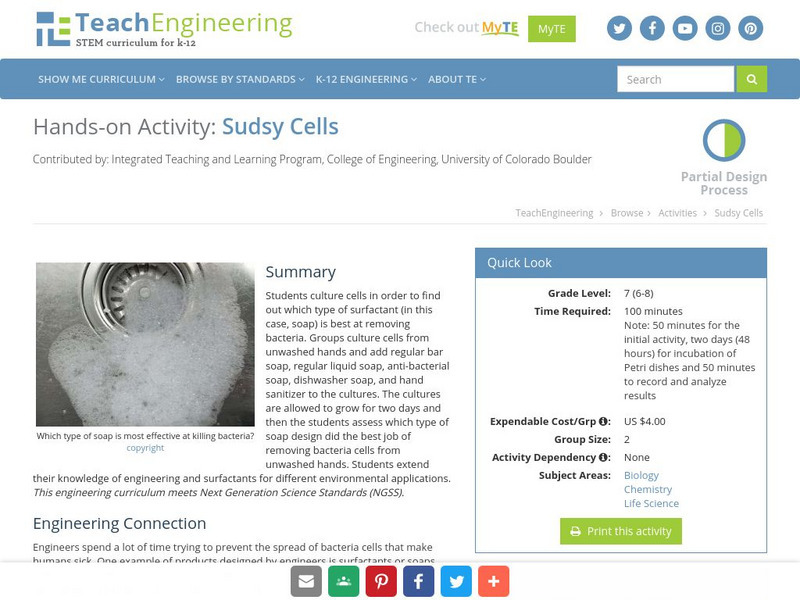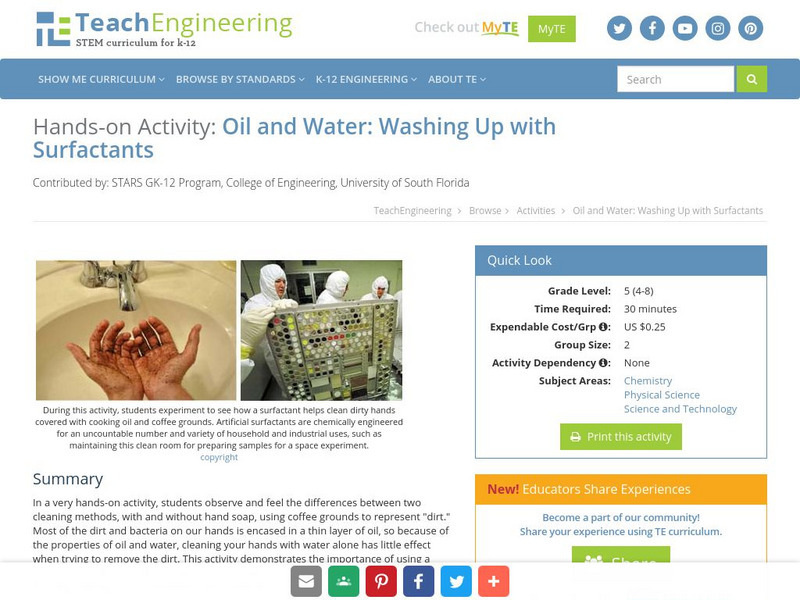Exploratorium
Cellular Soap Opera - Soap Films Can Behave Like Membranes
Soap, suds, and cell membranes. Pupils create a model of a cell membrane by using soap films. They experiment with trying to pass different objects through the film without popping it. Using a tube, they create a passageway through the...
University of Waikato
Investigating Bubbles
Bubbles are not always trouble. Pupils investigate surface tension in water and bubble mixtures by blowing bubbles and recording observations. Learners then create bubble wands of different shapes from pipe cleaners and observe the shape...
Nuffield Foundation
Investigating Anti-Microbial Action
Join the fight against bacteria. An open investigation shows pupils different aspects of antimicrobial substances, such as disinfectants, deodorants, or plant oils. They design and conduct their own experiments on the effectiveness of...
Teach Engineering
Sudsy Cells
Let's hope that your soap is doing what it's supposed to! The second of six installments in the Cells unit has scholars perform an experiment cultivating bacteria in Petri dishes. They test soaps and detergents to see which is most...
Project WET Foundation
Soap and Water Science
Learn about germs without getting sick! An interactive resource prompts learners to identify the dirtiest surfaces on a city street. Class members then participate in a demonstration about washing dirty hands and how using soap can kill...
Virginia Department of Education
Soap, Slime, and Creative Chromatography
Do you think chromatography paper suffers from separation anxiety? Young chemists make soap, slime, silly putty, and experiment with chromatography in this instructional activity. The material includes clear instructions for each...
Curated OER
The Progressive Era
Eighth graders utilize the SOAP method to analyze a work of art and relate it to what they know about the Progressive Era and the reasons why cities changed and the ways in which cities changed during the end of the 19th century. They...
Curated OER
Blow the Best Bubbles
Here is an exciting, and meaningful science lesson on the formation of bubbles! Young scientists have three cups with a variety of solutions in them. One cup has detergent only, one has glycerin added to it, and the third has corn syrup...
Curated OER
Social Studies: Thank you Mr. Carver
Learners explore the life of George Washington Carver and his inventions. they discover his uses for peanuts and sweet potatoes and how his inventions are still in use today. Students write letters to Carver about his inventions.
Curated OER
Making Soap
Students explore what chemical indicators are and use pH paper to determine if something is alkaline or basic. In this pH instructional activity students manufacture their own soap.
Curated OER
Making Soap
In this soap worksheet, students produce soap in the laboratory and test their product by washing away engine oil with their soap. Students answer four questions about tests they perform on their soap.
Curated OER
What is Soap?
Students investigate soap, how it is made and its structure. In this soap lesson, students observe a demonstration of soap being made. Students observe the properties of soap and how soap performs in "real-life" situations like cutting...
Curated OER
Melt and Pour Soap Recipes
Students are able to make many differnt kinds of soaps. They are told that they must purchase a pre-made melt and pour soap base from a craft supplier, melt it, add soap colorants and fragrances and otherr additives as you like and...
Curated OER
Floating Soap
Students use the Scientific Method steps to complete an experiment on various brands of soap to determine their floating capabilities. In this scientific method lesson, students write a hypothesis about the ability of various soap bars...
Curated OER
Soap, Wood, and Water
Students measure the properties of two different types of soap and wood and calculate their densities. Then they predict whether or not whether or not each object would float or sink in fresh or salt water.
Curated OER
Making Soap
Students recognize and use chemical indicators in the lab, recognize the need for safety while doing chemical experiments and understand the need for following precise directions.
Curated OER
Planet Dermis: How does soap clean me?
In this hygiene activity, students perform an 8 step experiment in which they learn how soap works to clean things. There are pictures to go along with the steps.
Curated OER
Fertilizer Frenzy
Pupils design and conduct an experiment testing the effect of fertilizers/soaps on algal growth. They estimate and predict, identify the variables, formulate a hypothesis, and record and analyze the data, presenting their findings in a...
Language Guide
Language Guide: El Bano
Most everything one would find in a bathroom will be found here. Audio and written vocabulary appear when mouse is moved over the illustration.
Chase Young, PhD
Dr. Chase Young, Ph D: Reader's Theater Script: No Bath Tonight [Pdf]
A reader's theater script for Jane Yolen's children's book, No Bath Tonight, is provided on these pages. Four character roles are needed in this activity.
Curated OER
Kids Health: Rashes: The Itchy Truth
Whether it is caused by a certain type of soap or chemical, or a certain plant, rashes aren't any fun. Read more about certain types of rashes, what to expect when you have a rash, and how to avoid getting them.
TeachEngineering
Teach Engineering: Sudsy Cells
Students culture cells in order to find out which type of surfactant (in this case, soap) is best at removing bacteria. Groups culture cells from unwashed hands and add regular bar soap, regular liquid soap, anti-bacterial soap,...
TeachEngineering
Teach Engineering: Down With the Clip!
Students see how surface tension can enable light objects (paper clips, peppercorns) to float on an island of oil in water, and subsequently sink when the surface tension of the oil/water interface is reduced by the addition of a...
TeachEngineering
Teach Engineering: Let's Get Dirty
In a very hands-on activity, students observe and feel the differences between two cleaning methods, with and without hand soap, using coffee grounds to represent "dirt."Most of the dirt and bacteria on our hands is encased in a thin...





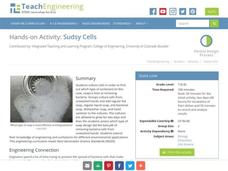


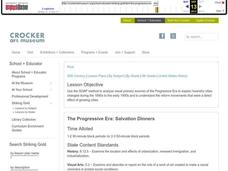

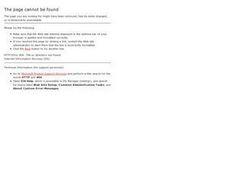




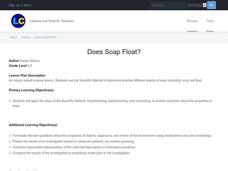





![Dr. Chase Young, Ph D: Reader's Theater Script: No Bath Tonight [Pdf] Activity Dr. Chase Young, Ph D: Reader's Theater Script: No Bath Tonight [Pdf] Activity](https://d15y2dacu3jp90.cloudfront.net/images/attachment_defaults/resource/large/FPO-knovation.png)

